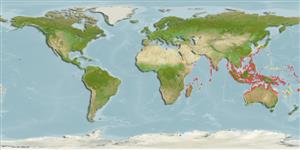Environment: milieu / climate zone / depth range / distribution range
Ecology
Marine; brackish; demersal; depth range 3 - 15 m (Ref. 90102). Tropical
Indo-West Pacific.
Size / Weight / Age
Maturity: Lm ? range ? - ? cm
Max length : 10.2 cm SL male/unsexed; (Ref. 1623)
Short description
Identification keys | Morphology | Morphometrics
Dorsal spines (total): 6 - 7; Dorsal soft rays (total): 9 - 10; Anal spines: 1; Anal soft rays: 8 - 9. Characterized by semi-translucent grey body with brown and white spotting; lower side of body with row of double blackish spots; pelvic fins united and frenum present; rounded caudal fin, about equal to head length; longitudinal scale series 22-26; ctenoid body scales and on nape; predorsal scales 8-11; cheek and opercle without scales; depth of body 5.5-6.1 in SL (Ref. 90102).
Solitary or in small groups. Inhabits sand-rubble bottoms in 3-15 m (Ref. 90102).
Life cycle and mating behavior
Maturities | Reproduction | Spawnings | Egg(s) | Fecundities | Larvae
Goren, M. and M. Dor, 1994. An updated checklist of the fishes of the Red Sea (CLOFRES II). The Israel Academy of Sciences and Humanities, Jerusalem, Israel. 120 p. (Ref. 12541)
IUCN Red List Status (Ref. 130435)
Threat to humans
Harmless
Human uses
Tools
Special reports
Download XML
Internet sources
Estimates based on models
Preferred temperature (Ref.
123201): 25.2 - 29.3, mean 28.6 °C (based on 2838 cells).
Phylogenetic diversity index (Ref.
82804): PD
50 = 1.0000 [Uniqueness, from 0.5 = low to 2.0 = high].
Bayesian length-weight: a=0.00692 (0.00376 - 0.01272), b=3.05 (2.89 - 3.21), in cm total length, based on LWR estimates for this species & (Sub)family-body (Ref.
93245).
Trophic level (Ref.
69278): 3.4 ±0.4 se; based on size and trophs of closest relatives
Resilience (Ref.
120179): High, minimum population doubling time less than 15 months (Preliminary K or Fecundity.).
Fishing Vulnerability (Ref.
59153): Low vulnerability (10 of 100).
